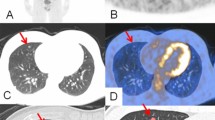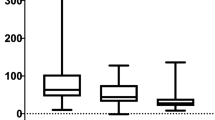Abstract
Purpose
The aims of this study were to assess the performance of FDG PET at PET/CT imaging for the detection of pulmonary metastases and to evaluate differences in lesion detectability on attenuation-corrected (AC) and non-attenuation corrected (NAC) PET images.
Methods
The institutional PET/CT database was searched for patients with pulmonary metastases of 3–60 mm in diameter. Ninety-two patients with 438 metastases to the lungs were included in the study. The primary tumours were 33 malignant melanomas, 12 carcinomas of unknown primary, 11 colorectal carcinomas, eight differentiated thyroid carcinomas, seven aggressive non-Hodgkin’s lymphomas, six head and neck cancers, three breast cancers, two prostate cancers and ten others. Lesion detectability was visually compared between PET and CT and between AC and NAC PET images using a five-point scale.
Results
Of the 438 pulmonary metastases, 174 were detected with FDG PET (39.7%), six of them on NAC images only (not significant). Visual scores were higher on NAC images in 41.4% and equal in 54.6% of lesions. The sensitivity of FDG PET increased significantly from 0.405 for metastases of 5–7 mm in diameter to 0.784 for lesions of 8–10 mm and to 0.935 for lesions measuring 11–29 mm in diameter. No metastases smaller than 5 mm in diameter were seen on PET images.
Conclusion
FDG PET/CT is useful for the assessment of pulmonary metastases. The frequency of lesion detection is similar for AC and NAC PET images. A reduced sensitivity of FDG PET has to be considered for lesions smaller than 11 mm in diameter.


Similar content being viewed by others
References
Rohren EM, Turkington TG, Coleman RE. Clinical applications of PET in oncology. Radiology 2004;231:305–32
Wahl RL. To AC or not to AC: that is the question. J Nucl Med 1999;40:2025–8
Farquhar TH, Llacer J, Hoh CK, Czernin J, Gambhir SS, Seltzer MA, et al. ROC and localization ROC analyses of lesion detection in whole-body FDG PET: effects of acquisition mode, attenuation correction and reconstruction algorithm. J Nucl Med 1999;40:2043–52
Kinahan PE, Townsend DW, Beyer T, Sashin D. Attenuation correction for a combined 3D PET/CT scanner. Med Phys 1998;25:2046–53
Townsend DW, Beyer T, Blodgett TM. PET/CT scanners: a hardware approach to image fusion. Semin Nucl Med 2003;33:193–204
Kinahan PE, Hasegawa BH, Beyer T. X-ray-based attenuation correction for positron emission tomography/computed tomography scanners. Semin Nucl Med 2003;33:166–79
Vansteenkiste JF, Stroobants SG. The role of positron emission tomography with 18F-fluoro-2-deoxy-D-glucose in respiratory oncology. Eur Respir J 2001;17:808–20
Zatz LM, Alvarez RE. An inaccuracy in computed tomography: the energy dependence of CT values. Radiology 1977;124:91–7
Beyer T, Antoch G, Blodgett T, Freudenberg LF, Akhurst T, Mueller S. Dual-modality PET/CT imaging: the effect of respiratory motion on combined image quality in clinical oncology. Eur J Nucl Med Mol Imaging 2003;30:588–96
Watson CC, Newport D, Casey ME. A single scatter simulation technique for scatter correction in 3D PET. In: Grangeat P, Amans JL, editors. Computational imaging and vision. Dordrecht, The Netherlands: Kluwer Academic Press; 1996. pp 255–68
Defrise M, Kinahan PE, Townsend DW, Michel C, Sibomana M, Newport DF. Exact and approximate rebinning algorithms for 3D PET data. IEEE Trans Med Imaging 1997;16:145–58
Hudson HM, Larkin RS. Accelerated image reconstruction using ordered subsets of projection data. IEEE 1994;13:601–9
Ost D, Fein AM, Feinsilver SH. The solitary pulmonary nodule. N Engl J Med 2003;348:2535–42
Gould MK, Maclean CC, Kuschner WG, Rydzak CE, Owens DK. Accuracy of positron emission tomography for diagnosis of pulmonary nodules and mass lesions. A meta-analysis. JAMA 2001;285:914–24
Dewan NA, Shehan CJ, Reeb SD, Gobar LS, Scott WJ, Ryschon K. Likelihood of malignancy in a solitary pulmonary nodule. Chest 1997;112:416–22
Nomori H, Watanabe K, Ohtsuka T, Naruke T, Suemasu K, Uno K. Evaluation of F-18 fluorodeoxyglucose (FDG) PET scanning for pulmonary nodules less than 3 cm in diameter with special reference to the CT images. Lung Cancer 2004;45:19–27
Beyer T, Townsend DW, Brun T, Kinahan PE, Charron M, Roddy R, et al. A combined PET/CT scanner for clinical oncology. J Nucl Med 2000;41:1369–79
Bengel FM, Ziegler SI, Avril N, Weber W, Laubenbacher C, Schwaiger M. Whole-body positron emission tomography in clinical oncology: comparison between attenuation-corrected and uncorrected images. Eur J Nucl Med 1997;24:1091–8
Imran MB, Kubota K, Yamada S, Fukuda H, Yamada K, Fujiwara T, et al. Lesion-to-background ratio in nonattenuation-corrected whole-body FDG PET images. J Nucl Med 1998;39:1219–23
Bleckmann C, Dose J, Bohuslavizki KH, Buchert R, Klutmann S, Mester J, et al. Effect of attenuation correction on lesion detectability in FDG PET of breast cancer. J Nucl Med 1999;40:2021–4
Kotzerke J, Guhlmann A, Moog F, Frickhofen N, Reske SN. Role of attenuation correction for fluorine-18 fluorodeoxyglucose positron emission tomography in the primary staging of malignant lymphoma. Eur J Nucl Med 1999;26:31–8
Skehan SJ, Coates G, Otero C, O’Donovan N, Pelling M, Nahmias C. Visual and semiquantitative analysis of 18F-fluorodeoxyglucose positron emission tomography using a partial-ring tomograph without attenuation correction to differentiate benign and malignant pulmonary nodules. Can Assoc Radiol J 2001;52:259–65
Raylman RR, Kison PV, Wahl RL. Capabilities of two- and three-dimensional FDG-PET for detecting small lesions and lymph nodes in the upper torso: a dynamic phantom study. Eur J Nucl Med 1999;26:39–45
Bai C, Kinahan PE, Brasse D. An analytic study of the effects of attenuation on tumor detection in whole-body PET oncology imaging. J Nucl Med 2003;44:1855–61
Erdi YE, Nehmeh SA, Pan T, Pevsner A, Rosenzweig KE, Mageras G, et al. The CT motion quantitation of lung lesions and its impact on PET-measured SUVs. J Nucl Med 2004;45:1287–92
Goerres GW, Burger C, Kamel E, Seifert B, Kaim AH, Buck A, et al. Respiration-induced attenuation artifact at PET/CT: technical considerations. Radiology 2003;226:906–10
Goerres GW, Kamel E, Seifert B, Burger C, Buck A, Hany TF, et al. Accuracy of image coregistration of pulmonary lesions in patients with non-small cell lung cancer using an integrated PET/CT system. J Nucl Med 2002;43:1469–75
Goerres GW, Kamel E, Heidelberg TNH, Schwitter M, Burger C, von Schulthess GK. PET-CT images coregistration in the thorax: influence of respiration. Eur J Nucl Med Mol Imaging 2002;29:351–60
Author information
Authors and Affiliations
Corresponding author
Rights and permissions
About this article
Cite this article
Reinhardt, M.J., Wiethoelter, N., Matthies, A. et al. PET recognition of pulmonary metastases on PET/CT imaging: impact of attenuation-corrected and non-attenuation-corrected PET images. Eur J Nucl Med Mol Imaging 33, 134–139 (2006). https://doi.org/10.1007/s00259-005-1901-1
Received:
Accepted:
Published:
Issue Date:
DOI: https://doi.org/10.1007/s00259-005-1901-1




